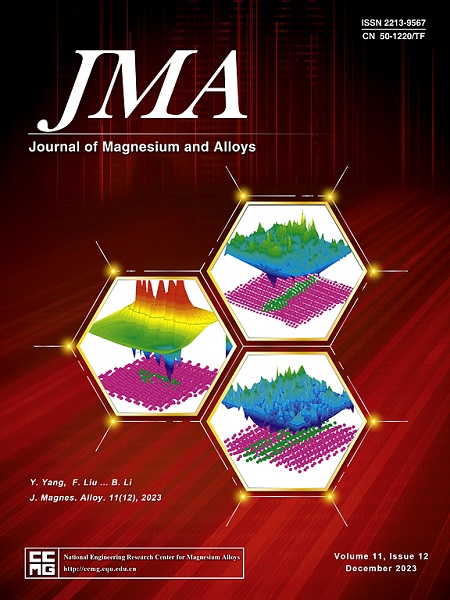Al添加对Mg-1Zn-1Y-0.1Mn合金板材组织、织构演变及力学性能的影响
IF 13.8
1区 材料科学
Q1 METALLURGY & METALLURGICAL ENGINEERING
引用次数: 0
摘要
系统地分析了Mg-xAl-1Zn-1Y-0.1Mn合金的显微组织和织构演变。Al的添加对Mg-1Zn-1Y-0.1Mn合金的晶粒细化没有影响,但添加0.5 wt. %或更多的Al元素会使组织从弱织构转变为强基织构。仅添加0.1 wt. %的Al元素,Mg-1Zn-1Y-0.1Mn合金中Mg3Zn3Y2相的主要第二相颗粒转变为Al2Y相,0Al、0.1Al、0.3Al、0.5Al和1Al合金中溶解Y元素的浓度分别为0.50、0.31、0.23、0.15和0.06 wt. %。虽然0.5 wt. %或更多Al添加量的合金比0.3 wt. %或更少Al添加量的合金具有更高的棱柱形< >滑动的施密德因子,但低Al含量的合金比高Al含量的合金具有更高的棱柱形< >滑动活性。结果表明,在Mg-Zn-RE合金中加入大量Al元素会使合金中溶解的Y元素显著减少,导致合金的棱柱体< a >滑移活性显著降低,导致合金的室温成形性变差。本文章由计算机程序翻译,如有差异,请以英文原文为准。

Effect of Al addition on microstructure, texture evolution and mechanical properties of Mg-1Zn-1Y-0.1Mn alloy sheets
The microstructure and texture evolution of Mg-xAl-1Zn-1Y-0.1Mn alloys are systematically analyzed. There is no effect of Al addition on grain refinement in the Mg-1Zn-1Y-0.1Mn alloy, but the addition of 0.5 wt.% or more Al element dramatically changes texture from a weak texture to a strong basal texture. The predominant second phase particle of Mg3Zn3Y2 phase in the Mg-1Zn-1Y-0.1Mn alloy changes to Al2Y phase by the addition of only 0.1 wt.% Al element, and the concentrations of dissolved Y element in the 0Al, 0.1Al, 0.3Al, 0.5Al and 1Al alloys are 0.50, 0.31, 0.23, 0.15 and 0.06 wt.%, respectively. Although the 0.5 wt.% or more Al-added alloys have higher Schmid factor for prismatic 〈a〉 slip than the 0.3 wt.% or less Al-added alloys, the lower Al containing alloys show much higher activity of prismatic 〈a〉 slip than the higher Al containing alloys. It demonstrates that the addition of high amount of Al element in Mg-Zn-RE alloy dramatically decrease the dissolved Y element, resulting in a significant deterioration of activity of prismatic 〈a〉 slip and consequently a poor formability at room temperature.
求助全文
通过发布文献求助,成功后即可免费获取论文全文。
去求助
来源期刊

Journal of Magnesium and Alloys
Engineering-Mechanics of Materials
CiteScore
20.20
自引率
14.80%
发文量
52
审稿时长
59 days
期刊介绍:
The Journal of Magnesium and Alloys serves as a global platform for both theoretical and experimental studies in magnesium science and engineering. It welcomes submissions investigating various scientific and engineering factors impacting the metallurgy, processing, microstructure, properties, and applications of magnesium and alloys. The journal covers all aspects of magnesium and alloy research, including raw materials, alloy casting, extrusion and deformation, corrosion and surface treatment, joining and machining, simulation and modeling, microstructure evolution and mechanical properties, new alloy development, magnesium-based composites, bio-materials and energy materials, applications, and recycling.
 求助内容:
求助内容: 应助结果提醒方式:
应助结果提醒方式:


